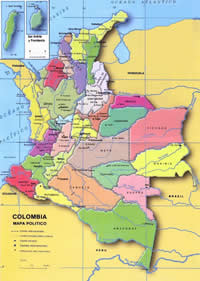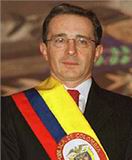| Home > Colombia |
COLOMBIA:
Country Profile of Colombia
The Republic of Colombia, is the north westernmost country of South America. Colombia is bordered to the east by Venezuela and Brazil; to the south by Ecuador and Peru; to the North by the Atlantic Ocean, through the Caribbean Sea; and to the west by Panama and the Pacific Ocean. Colombia is also the only country in South America that borders both the Atlantic and the Pacific Ocean.
Colombia is a large and physically diverse nation. It is the fourth-largest country in South America (after Brazil, Argentina, and Peru), with an area seven times greater than that of New England; more than twice that of France; Its vast territory is one of great physical contrasts, ranging from the towering, snow capped peaks of the Andes to the hot, humid plains of the Amazon River Basin. Not only is Colombia large in area, but it also has a large population, containing more people than any other South American country except Brazil. The nation's population is not evenly distributed. Most of the people live in the mountainous western third of the country, where Bogotá, the capital, and most of Colombia's other large cities are located.
Colombia is a large and physically diverse nation. It is the fourth-largest country in South America (after Brazil, Argentina, and Peru), with an area seven times greater than that of New England; more than twice that of France; Its vast territory is one of great physical contrasts, ranging from the towering, snow capped peaks of the Andes to the hot, humid plains of the Amazon River Basin. Not only is Colombia large in area, but it also has a large population, containing more people than any other South American country except Brazil. The nation's population is not evenly distributed. Most of the people live in the mountainous western third of the country, where Bogotá, the capital, and most of Colombia's other large cities are located.
|
☻Capital: - Bogotá ☻Area: - Total: 1,141,748 km² (26th) 440,839 sq mi - Water (%: )8.8 ☻Independence: from Spain - Declared: July 20, 1810 - Recognised: August 7, 1819 |
☻Official languages: - Spanish ☻Population: - July 2005 census: 45,600,000 (28th) - 2005 census: 42,090,502 - Density: 40/km² (161st) 104/sq mi |
Geography of Colombia:
 The country of Columbia over the years has been divided into four different regions, namely, the Andean highlands, the Caribbean lowlands coastal region, the Pacific lowlands coastal region and eastern Columbia. The Andean Highlands are near the front of Ecuador where the Andes Mountains separate into three marked chains or cordilleras that reach northward to the Caribbean Sea. The altitudes of these mountains reach over 5,700 meters and are permanently covered with snow. The Cordillera Occidental in the west, in the center and in the east all are different in their characteristics, however it is these mountains that make this country so beautiful. Heading down to the Caribbean Lowlands you will find a beautiful region shaped like that of a triangle. In this area are small cities, tranquil streams, and shallow lakes that help with the growth of cotton plantations, farming and cattle ranches. In the Pacific Lowlands, few people of Columbia reside there as it is namely made up of jungle and swamps. In eastern Columbia, about 3/5´s of the country´s total area is made up of land with little vegetation and population.
The country of Columbia over the years has been divided into four different regions, namely, the Andean highlands, the Caribbean lowlands coastal region, the Pacific lowlands coastal region and eastern Columbia. The Andean Highlands are near the front of Ecuador where the Andes Mountains separate into three marked chains or cordilleras that reach northward to the Caribbean Sea. The altitudes of these mountains reach over 5,700 meters and are permanently covered with snow. The Cordillera Occidental in the west, in the center and in the east all are different in their characteristics, however it is these mountains that make this country so beautiful. Heading down to the Caribbean Lowlands you will find a beautiful region shaped like that of a triangle. In this area are small cities, tranquil streams, and shallow lakes that help with the growth of cotton plantations, farming and cattle ranches. In the Pacific Lowlands, few people of Columbia reside there as it is namely made up of jungle and swamps. In eastern Columbia, about 3/5´s of the country´s total area is made up of land with little vegetation and population. Columbia is situated in the northwestern part of South America and is bordered by Venezuela and Brazil to the east, Ecuador and Peru to the south, the Atlantic ocean through the Carribean Sea to the north, Panama to the northwest and the Pacific Ocean to the west. Other maritime borders are shared with Caribbean countries such as Jamaica, Haiti, the Dominican Republic, Honduras, Nicaragua and Costa Rica. The capital of Columbia is Bogota with a population of over 7,000,000 people.
Education in Colombia:
 The educational system in Colombia has evolved over years of influence from the Catholic Church and the government´s control. For many years during the 1900´s, schooling was divided into a primary level and a secondary level system due to the child´s social class. University education was only allowed for the elite class and those who had attended academic schools and not vocational. It was not until after World War II that the system began to change.
The educational system in Colombia has evolved over years of influence from the Catholic Church and the government´s control. For many years during the 1900´s, schooling was divided into a primary level and a secondary level system due to the child´s social class. University education was only allowed for the elite class and those who had attended academic schools and not vocational. It was not until after World War II that the system began to change.During the 1960´s the sector of education began to grow and expand. By the mid 1980´s, the number of enrolled students for primary school had more than doubled. Secondary school enrollment had grown sixfold, and the number of university students had increased fifteen times. The improvement of education during this time was due namely to government funding. National legislation helped increase awareness and further responsibility to provide aid to the education financing. Financial responsibility was taken for primary and secondary schools. Though much improvement was seen, discrimination between social classes continued to persist. With all of that being said however, the illiteracy rate in the country is declining, having dropped from an estimated 90% at the end of the 19th century to an estimated 8.2% in 2000. Like other Latin American countries however, drop out rates among students in the primary age group are higher than desired. In rural areas of the country, children live far away from the schools making it more of a motivation to drop out. Secondary schools are found mostly in urban areas which continue to encourage the separation of class division in the educational system. The government is trying to assist this problem by establishing programs for improving secondary education.
Higher education is growing rapidly throughout the country of Colombia. The National University located in Bogotá, is actually one of the oldest universities in the Western Hemisphere, founded in 1572. Although higher education learning has been expanding, a problem that still exists today is the lack of faculty. Most faculty members that were hired to teach did not have the appropriate training or qualifications needed. Although these private and public institutions are flourishing, it has been agreed upon that the quality of the education is lacking as a result.
Health in Colombia:
 Though health standards in Colombia have greatly improved since the 1950´s, there are still many medical problems affecting the country. Malaria is still a problem especially for those living in lower altitudes, and many Colombians suffer from intestinal parasites. The health care system has worked hard over the years to improve the quality and the availability of good health care to those who are unable to afford it or have access to it. In the early 1990´s, Colombia broke away from its older health care system to one of payment by capitation. This brought about competition among integrated health care service delivery systems. The health care system, prior to this new development was set up to exclude over 5 million people in the poorest groups throughout the country. With this new development, more people are able to receive the health care needed.
Though health standards in Colombia have greatly improved since the 1950´s, there are still many medical problems affecting the country. Malaria is still a problem especially for those living in lower altitudes, and many Colombians suffer from intestinal parasites. The health care system has worked hard over the years to improve the quality and the availability of good health care to those who are unable to afford it or have access to it. In the early 1990´s, Colombia broke away from its older health care system to one of payment by capitation. This brought about competition among integrated health care service delivery systems. The health care system, prior to this new development was set up to exclude over 5 million people in the poorest groups throughout the country. With this new development, more people are able to receive the health care needed.Unfortunately, malnutrition is still an epidemic that many children in Colombia face, especially out in the rural areas of the country. Though the statistics show a great improvement, as of the year 2000, an estimated 15 percent of children under five years old were considered to be malnourished. Only 91 percent of the population had access to safe drinking water and 85 percent had sufficient sanitation. Sadly, the health care situation in Colombia is severely lacking compared to other countries in Latin America.
Politics in Colombia:
 Colombia is a country that is notorious for its drug production, kidnappings, and high murder rate. Though the government of Colombia is not a direct cause for this chaotic country, it is no doubt influenced by its people and the negative occurrences that are happening there. During the 1990´s, Colombia became the world´s largest producer of cocaine and coca derivatives as well as having the highest murder rate in the world. Though it has descended over the years, the government is still trying to take control of the terrorism and drug-trafficking in the country.
Colombia is a country that is notorious for its drug production, kidnappings, and high murder rate. Though the government of Colombia is not a direct cause for this chaotic country, it is no doubt influenced by its people and the negative occurrences that are happening there. During the 1990´s, Colombia became the world´s largest producer of cocaine and coca derivatives as well as having the highest murder rate in the world. Though it has descended over the years, the government is still trying to take control of the terrorism and drug-trafficking in the country.In the year 2006, the government of Colombia destroyed over 180,000 acres of coco plants with another 125,000 acres destroyed in 2007 and the remaining 50,000 acres left for 2008. There are hopes that with the government taking charge, crime will diminish in this country.
Throughout the 19th and early 20th centuries, each party held the presidency for roughly equal periods of time. Colombia was able to sustain the tradition of civilian government and regular, free, elections. Though the country has been committed to democratic institutions, Colombia's history also has been characterized by widespread, violent conflict, years before the current aggressive situation. Two civil wars resulted from bitter rivalry between the Conservative and Liberal parties: The War of a Thousand Days (1899-1903) claimed an estimated 100,000 lives and La Violencia (the Violence) (1946-1957) took about 300,000 lives.
The government as it stands now is in the framework of a presidential representative democratic republic and was established as such in the Colombian Constitution back in 1991. It is a complicated process though with three electoral processes in order to elect candidates for a period of four years. The last elections back in 2006 saw Alvaro Uribe take office once again.